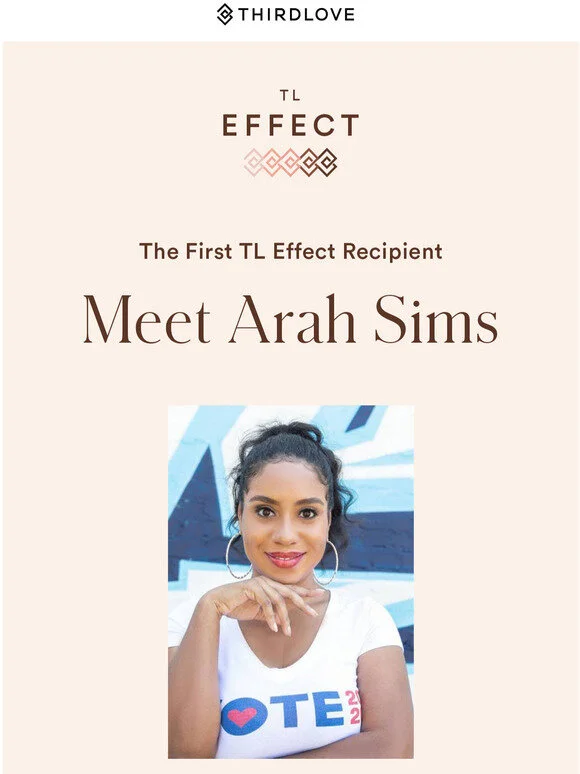ThirdLove CEO Heidi Zak: Supporting Women With Brand Purpose
Heidi Zak has been in finance, retail, and plenty of dressing rooms trying to find the right bra. So she created ThirdLove and disrupted an entire vertical—uplifting women with purpose.
“The photographer said to us, ‘What brand are you trying to emulate?’ That's really in essence what a lot of startups do. But we said ‘We don't want to be like any bra brand. We don't want to look like any of them.’”
By E.B. Moss
Heidi Zak, now CEO of one of the largest online bra and underwear companies in America, has been in finance, retail and tech. And, like most women, she’s also been in plenty of dressing rooms trying to find the right bra. So, she took all of that professional and personal experience, created ThirdLove and disrupted an entire traditional industry vertical—to the great relief of uncomfortable women everywhere.
Heidi’s first-to-market DTC bra business hit some, ah, curves, along the journey but led to Zak being named to everything from Goldman Sachs’ 100 Most Intriguing Entrepreneurs list to Fortune’s 40 Under 40, and more. Part of the accolades stem from how Zak has approached both brand marketing and brand purpose, each with a focus on Inclusivity. At ThirdLove that means product innovation and transformative aid, offering bras in some 80 sizes including their unique half-cup sizing, and donating over $40 million worth of those products to women in need.
A Foundation of Purpose
Building in purpose from the get-go has resulted in new growth in an old school industry previously defined by a narrow concept of beauty. Zak described both the evolution in the shopping experience and the marketing stance:
“We didn’t want to look like any other bra brand which mostly photographed skinny, generally white women with small boobs and generally did it in a really sexy way. So, we set out to build something radically different from scratch.... Back then there were barely any plus size models.”
Traveling a path from small town Main Street to Wall Street, Herald Square to Silicon Valley, Zak found her way to disruption in 2012 through meeting the founders of what became Lyft. That literally drove her own inspiration to solve a consumer problem, one bra at a time. What existed for bra shopping at that time, she noted, were “department stores and Victoria’s Secret and some big box stores. There certainly weren't online bra brands at the time. And that was the idea: better brand, better product, better online shopping experience for women.”
Zak recalled their early-stage positioning, and shared clear insights into the inclusive DNA of the product:
“I still remember our first photo shoot in San Francisco. The photographer said to us, ‘What brand are you trying to emulate?’ That's really in essence what a lot of startups do. But we said ‘We don't want to be like any bra brand. We don't want to look like any of them. There is no comp for what we're trying to create, because all these bra brands do is shoot skinny, generally white women with generally small B cup boobs and they generally do it in a really sexy way. ... And so, we set out to build something radically different from scratch.”
It was the right intention at that time, Zak lamented, there were few plus size models “and certainly no women with stretch marks or those kinds of things. That didn't really exist.”
So, after finding “real women” models through friends and Craigslist, a new look for lingerie was born -- and a new approach to bra buying.
Innovating to Stand Out
In those early days, direct-to-consumer was not a common phrase or approach in targeting female consumers beyond the Birchboxes and Warby Parkers. And there was a distinct lack of awareness or education about “bra best practices.”
“No one was really vertically integrated in apparel in any category. So, we set out to have a direct relationship with the customer, especially in a category where we felt education was lacking in a huge way. Even for me, until I started Third Love, I was wearing the wrong bra size and wearing my bra the wrong way: I was putting it on the middle or the tightest hook when I got it. You want it to be on the loosest hook and it should be snug when you buy it. Unless you have a bra-fitter mom, you don't know these things. Being direct-to-consumer was a direct way to speak to our customer, to educate her, to bring her along the journey, to make her feel comfortable.”
Breaking the mold of bra-shopping to be an online experience took some convincing within a pool of mostly male investor prospects. Having her husband as co-founder smoothed that challenge to a degree but marketing the direct buying approach to shoppers also tested Zak’s ingenuity.
Most women were happy to shift from awkward encounters with a stranger and a measuring tape in a fitting room, and those who tried the ThirdLove 24/7 best-selling model loved it, but now more women needed convincing if they were to scale. That’s when Zak came up with the “Debbi Fields” sampling approach to bra shopping: try before you buy.
“We basically said let's de-risk the situation for the customer and put out ads saying, ‘Ready to graduate from Victoria's Secret? Try this bra for free.’ In this program, we would send a woman a T-shirt bra, store her credit card information, and then charge her after 30 days if she kept the bra. It was the idea of no risk upfront to the customer. And it worked. We ran that program for close to three years and it allowed us to acquire well over a million customers in that time period.”
“We set out to have a direct relationship with the customer, especially in a category where we felt education was lacking in a huge way. Being direct-to-consumer was a direct way to speak to our customer, to educate her, to bring her along the journey, to make her feel comfortable.”
Another smart move was embracing podcasting. Emblematic of the “canary in the coalmine” approach of many start-ups in a then-quite affordable new medium, ThirdLove began advertising in on-demand audio and drove strong product demand.
Zak recalls their ad options back around 2015: “We had three main channels in the early days of ThirdLove. Instagram was just starting, and you couldn’t advertise there yet, so it was Facebook, podcasts, and the third was YouTube. But I remember saying to one of our investors ‘we're starting to advertise on podcasts. It's really effective.’ And he was like, ‘Podcasts?’ And they’re still really effective.”
Growth enabled them to try TV a couple of years later. As Zak acknowledges, “Now of course you have OTT and all the streaming services. So again, that world has evolved tremendously over the past few years, as well as during the pandemic with a lot more people watching a lot more content on all these services.”
But it comes with a content caveat: “I think linear specifically can work really well, but it also can not work really well. You have to be careful and thoughtful about the content you're putting out there. Because as I like to always say, marketing and the platforms are one piece of it, but most important is the content, the creative and the messaging: if you don't have that right content for any one of these channels, it's not going to work or be effective.”
Their marketing efforts also include some high-profile figures – Katie Couric is an investor – as well as “micro-influencers,” which continues that alignment with “real women” once again.
Also evolved? The DTC world overall. Today, Zak believes, most companies can or do have a DTC component “because they need to; the pandemic has furthered that. ...If you think about six or seven years ago to today, it's dramatically different.”
Bringing Brand Purpose to Life
That direct customer relationship that Zak sought from the inception of ThirdLove, and so essential today for all companies, continues to manifest with their purpose-driven extensions. For a company that literally supports women physically, they created the TL Effect to virtually support female founders of color, too.
As COVID and the issues around Black Lives Matter impacted so many, the company aimed to find a way to help impact change. Having had to lay off 30% of their own team, a financial donation did not seem appropriate, but they had the experience and the platform to help in other ways.
Further iterating on their commitment to inclusivity, ThirdLove launched a new initiative during COVID-challenged 2020: The TL Effect, supporting entrepreneurial women of color via grants, mentoring, even brand exposure on ThirdLove channels and workspace if needed.
“The TL Effect is a program that is something we can do as a company that 1) lets our team get involved 2) creates some type of actual change that we can look at, and hopefully see the progress and 3) is something that kind of creates a little bit of a flywheel effect: we can give them a little more of a voice in a crowded marketplace today.”
The pro-social initiative launched in June and awarded its first recipient, Arah Sims, founder of Kewtie Nails, with a grant, mentorship and promotion of her product and brand through the ThirdLove platforms. For Cohort Two of nominees, Simms is now on the selection committee for the next winner.
For ThirdLove, the giving goes inward, too. Zak explains that “The TL Effect is really our outward facing program for the community at large. We also wanted to see what can we do internally at ThirdLove to create a stronger workforce and understanding of each other. And so unconscious bias was our first training we did for DEI efforts. ... Now we're doing some training around micro-aggressions, what are they, what do they look like? How do we recognize them? We’re really trying to help educate ourselves at ThirdLove and push the company and each individual forward in a really healthy and positive way.
Does she truly believe brand purpose supports the bottom line?
“A hundred percent,” said Zak. “That used to be a debate five or 10 years ago. I think today it's very clear that the brands who stand for something and maybe even stand for something that not everybody loves, are succeeding.”
Ed Note: You can hear the full interview as a podcast here: Insider Interviews with E.B. Moss, Ep 26, or on YouTube:
March 30, 2021






